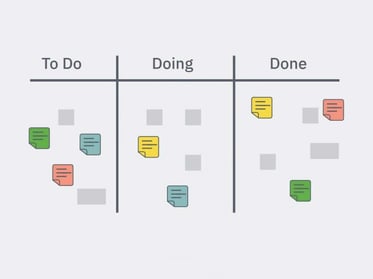Kanban #1: Transparency increses self-efficacy in agencies
Your desk is overflowing with started tasks, the workload seems impossible to manage, new tasks are constantly coming at you, and you barely have an idea how much work they involve and how things currently stand. That’s basically how many people view their work situations, and of course the key question is: if that’s how things are, how can we do things better?
Since the mid-20th century, Toyota has been investigating how to boost productivity to become more competitive. Toyota’s response is “lean management”, in other words: creating value without waste. The aim is to optimally coordinate all activities required for creating added value and avoid superfluous activities. For this purpose, Taiichi Ōno developed the Kanban method in 1947. The idea is to “organise the flow of material in production according to the supermarket principle, meaning when a consumer takes a product from the shelf with certain specifications and of a certain quantity, that gap is noted and the product replenished.” [Günther Zäpfel: Strategisches Produktions-Management. 2. Auflage. (Strategic Production Management. 2nd Edition.) Oldenbourg, 2000, p. 228]

Nowadays, Kanban is being successfully used in different forms in all entrepreneurial tasks and is a key component in organising work. The consistent transparency enables employees to realise their potential through self-efficacy and thus achieve the best-possible customer service.
In the method’s simplest form, work steps are recorded in the columns To Do, Doing, and Done. This is particularly effective in the marketing and sales world, given the way it divides labour and the increasing number of channels, platforms, media, and interactions. The respective work processes are then visualised using detailed tickets.
The principles of Kanban
- Start with what you’re doing now – create transparency across all tasks, such as social media communication, trade fair appearances, online shops, management events, brochures, film production, and everywhere else.
- Go after incremental, evolutionary changes – transparency for everyone involved enables weaknesses to be detected in throughput times, completions, or in making corrections, so that they can be gradually optimised.
- Respect initial processes, roles, responsibilities, and job titles – the existing company organisation as well as decision-making and managerial structures are also demonstrated transparently and respected.
In the provision of agency services – like with any production process – these six practices are at the core of Kanban:
- Depict the work visually and make it visible – just like on a real-time roadmap showing construction sites and traffic jams, the Kanban board makes work visible, provides guidance, and enables optimisations through detours to more ideal driving routes (work sequences).
- Limit the WIP (= work in progress, parallel work) and live by the motto of “Stop starting, start finishing”. Multitasking, a mountain of tasks, and semi-finished results are inefficient and exhausting. That’s why the number of simultaneous tasks must be limited.
- Manage the flow – the key point is: manage the work – not the people working. The key focus is on generating value for customers. This gives employees the opportunity to contribute and live up to their potential.
- Make process rules explicit – customer-decentralised, media-specific and site teams work on different agency services. Rules are necessary and must be complied with sensibly. The pull principle not only focuses on creating value for customers but also enables all employees work in an independent and effective way. Employees take on (pull) tasks in the Kanban board on their own.
- Implement feedback mechanisms (workflow and organisation). Rather than instructions and decisions taken on other levels, it is established feedback mechanisms in the team, such as stand-up meetings or retrospectives, that form the foundations for change.
- Carry out joint improvements – „“The current state of affairs is the worst” is the way of thinking in lean management – the foundation for the continuous improvement process..
Read this blog post to learn more about the benefits every marketing & communication department reaps based on the Kanban method with ORT’s Marketing Management Cockpit (MMC): “Kanban: New quality of collaboration in marketing and communication”.





